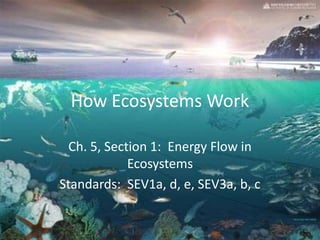
Unit 2 a ch 5 s1 energy flow in ecosystems
- 1. How Ecosystems Work Ch. 5, Section 1: Energy Flow in Ecosystems Standards: SEV1a, d, e, SEV3a, b, c
- 2. What’s sun got to do with it, got to do with it…? • Energy from sun helps plants/algae make carbohydrate food molecules through PHOTOSYNTHESIS. • Ingredients: – – – – CO2 (from the air) H2O (from soil) Sunlight provides the energy These CO2 and H2O molecules are broken and reformed as C6H12O6 which is glucose. • This carbohydrate food from plants/algae is the base of all food chains.
- 3. An Exception to the Rule: Deep Ocean Ecosystems • Hydrothermal vents located at the bottom of the ocean off coast of Ecuador. • These ecosystems do not get sunlight= no plants/algae • What is the base of the food chain? • Specialized bacteria are able to take sulfur from water surrounding vent and turn it into food. • These bacteria are the base of the food chain in this ecosystem.
- 4. How do organisms get energy from food they eat? • Plants & animals break down this carbohydrate food and release energy from the molecules via CELLULAR RESPIRATION. • C6H12O6 (glucose) is broken down using oxygen that was “breathed” in and creates ATP energy and CO2. • ATP energy is used for everyday activities, growth, development, et c. • Plants & animals are interdependent on each other. – Plants give animals the O2 and food. – Animals give plants the CO2 to make the food.
- 5. What are the different types of organisms in an ecosystem? • Producers – – – – – AKA: autotroph “Auto”- self “Troph”- feeder Make their own food Ex: plants & algae • Consumers – – – – AKA: heterotroph “Hetero”- other “Troph”- feeder Must consume other organisms to get energy – Ex: animals, most bacteria, fungi
- 6. What are the different types of consumers/heterotrophs? • Herbivores – Energy source: plants – Example: cows, deer • Carnivores – Energy source: other consumers – Example: lion, snake • Omnivores – Energy source: producers & consumers – Example: bear, rat, human
- 7. What are the different types of consumers/heterotrophs? • Decomposers – Energy source: break down and ABSORB nutrients thru cell wall – Example: bacteria, fungi • Scavengers – Energy source: eat dead/ decomposing material with mouth; LARGER organisms – Example: vulture; hyena • Detritivores – Energy source: eat dead/decomposing material with mouth; SMALLER organisms – Example: worm, roly poly
- 8. How is energy transferred through an ecosystem? • Food chains, Food webs, & trophic levels can tell us – how energy is transferred – how much energy is transferred between organisms • These also show which organisms are dependent on others for survival.
- 9. What are trophic levels? • Trophic levels are the steps through which energy is transferred from one organism to the next. • 90% of the energy consumed by an organism… – Is used up by that organism to grow & develop – Is lost from that organism as heat & waste • 10% of the energy is stored in its tissues and can be passed to another animal when it gets eaten. Yellow arrows show release of heat Orange arrows show release of waste (feces) Red pyramid shows only 10% of the level below is transferred upward. (10% of 10,000 = 1,000)
- 10. What are trophic levels? • Primary Producersplants/algae • Primary Consumers- get energy from producers (herbivore) • Secondary Consumers- get energy from primary consumers (carnivores) • Tertiary consumers- get energy from secondary consumers (carnivores/omnivores) • Quaternary consumers- get energy from tertiary consumers (carnivores/omnivores)
- 11. How is a food chain different from a food web? • Food chains show ONE set of relationships in an ecosystem. • Arrows show TRANSFER OF ENERGY not who eats who. • Say to yourself, “The energy from the bigger fish goes into the killer whale.”
- 12. How is a food chain different from a food web? • Food webs show NUMEROUS relationships in an ecosystem. • Food webs are more detailed and show that usually an organism relies on more than one source of food.
- 13. What can an energy pyramid tell us? • A way to visualize the loss of energy from one trophic level to the next. • Each level of pyramid represents a trophic level. • Show that most energy is located at the bottom of the pyramid (producers) and less energy is available to the top consumers.
- 14. How does energy loss affect an ecosystem? • Less energy affects the organization of an ecosystem. • Because energy is lost, there are fewer organisms as you go up the pyramid. • Also, there are limited numbers of trophic levels because of loss of energy. Not enough energy to support more than 3-5 trophic levels.
- 15. Ask yourself… • What would happen to the rodents if there was more than one owl in this ecosystem? • What would then happen to the grasshopper population? • What would then happen to the producer population?
Notas do Editor
- Breathed is in quotes b/c not all organisms breathe- plants, bacteria, etc.